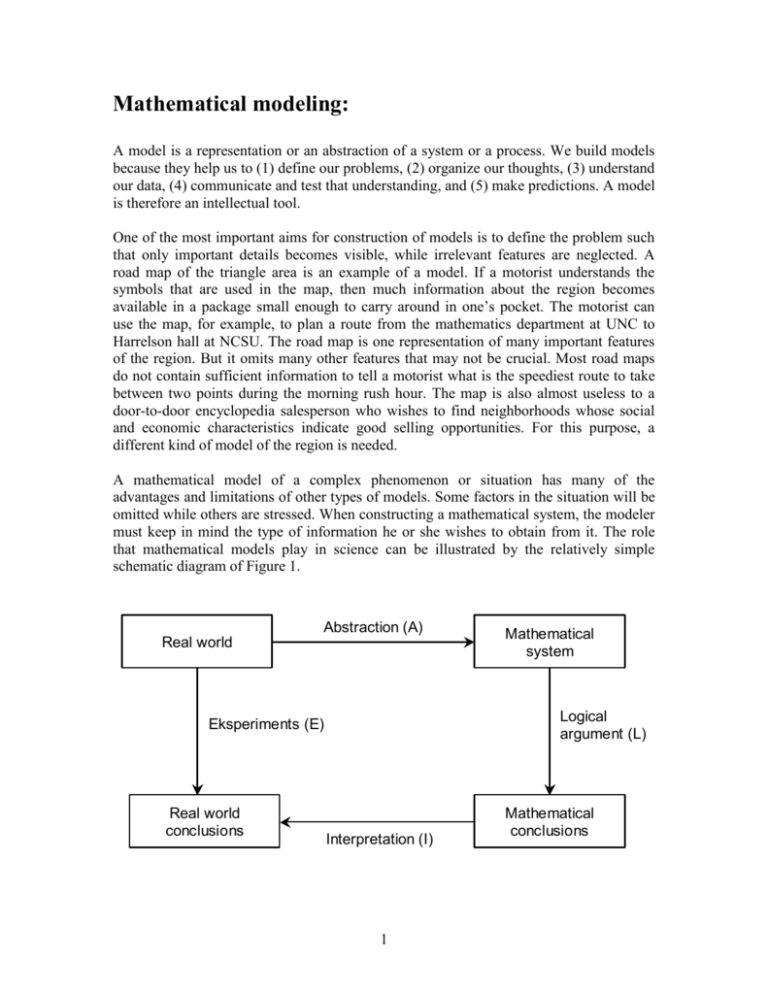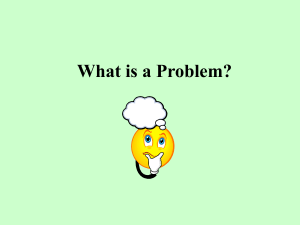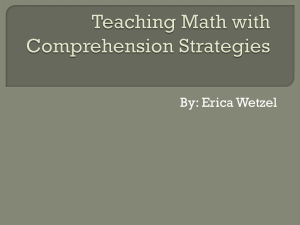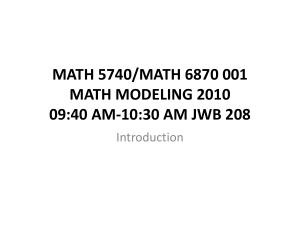Mathematical modeling:
advertisement

Mathematical modeling: A model is a representation or an abstraction of a system or a process. We build models because they help us to (1) define our problems, (2) organize our thoughts, (3) understand our data, (4) communicate and test that understanding, and (5) make predictions. A model is therefore an intellectual tool. One of the most important aims for construction of models is to define the problem such that only important details becomes visible, while irrelevant features are neglected. A road map of the triangle area is an example of a model. If a motorist understands the symbols that are used in the map, then much information about the region becomes available in a package small enough to carry around in one’s pocket. The motorist can use the map, for example, to plan a route from the mathematics department at UNC to Harrelson hall at NCSU. The road map is one representation of many important features of the region. But it omits many other features that may not be crucial. Most road maps do not contain sufficient information to tell a motorist what is the speediest route to take between two points during the morning rush hour. The map is also almost useless to a door-to-door encyclopedia salesperson who wishes to find neighborhoods whose social and economic characteristics indicate good selling opportunities. For this purpose, a different kind of model of the region is needed. A mathematical model of a complex phenomenon or situation has many of the advantages and limitations of other types of models. Some factors in the situation will be omitted while others are stressed. When constructing a mathematical system, the modeler must keep in mind the type of information he or she wishes to obtain from it. The role that mathematical models play in science can be illustrated by the relatively simple schematic diagram of Figure 1. Abstraction (A) Real world Logical argument (L) Eksperiments (E) Real world conclusions Mathematical system Interpretation (I) 1 Mathematical conclusions The scientist begins with some observations about the real world. He or she wishes to make some conclusions or predictions about the situation he or she has observed. One way to proceed (E) is to conduct some experiments and record the results. The model builder follows a different path. First, he or she abstracts, or translates, some of the essential features of the real world into a mathematical system. Then by logical argument (L) he or she derives some mathematical conclusions. These conclusions are then interpreted (I) as predictions about the real world. To be useful, the mathematical system should predict conclusions about the real world that are actually observed when appropriate experiments are carried out. If the predictions from the model bear little resemblance to what actually occurs in the real world, then the model is not a good one. The modeler has not isolated the critical features of the situation being studied or the axioms misrepresent the relations among these features. On the other hand, if there is good agreement between what is observed and what the model predicts, then there is some reason to believe that the mathematical system does indeed capture correctly important aspects of the real-world situation. What happens quite frequently is that some of the predictions of a mathematical model agree quite closely with observed events, while other predictions do not agree with the observed events. In such a case, we might hope to modify the model to improve its accuracy. The incorrect predictions may suggest ways of rethinking the assumptions of the mathematical system. One hopes that the revised model will not only preserve the correct predictions of the original one, but that it will also make further correct predictions. The incorrect inferences of the revised model will lead, in turn, to yet another version, more sophisticated more accurate than the previous one. However, it is important to keep in mind, that the goal is not to make the most precise model of the part of the world that is modeled, but that the model (like the road map) includes all the essential features, even if that means that some other features in the model do not present the reality. For example, a model of the cardiovascular system (the heart, arteries, and veins) could accurately present the systemic arteries and veins and then lump the pulmonary circulation into a single compartment. Such a compartment would never represent any of the subsystems correctly. When building mathematical models one should distinguish between the different types of models, some models (deterministic models) can be derived directly from physical laws (e.g. Newton’s second law), while other models are based on empirical observations. Both types of models provide insight into the system modeled, but the type of model must be considered carefully. For example, very different types of models are used for predict the weather tomorrow and to determine a rockets trajectory to the moon. Holling (1978) has a diagram (Figure 2) that provides a simple and useful classification of problems. The horizontal axis represents how well we understand the problem we are trying to solve; the vertical axis represents the quality and/or quantity of relevant data (Figure 2). Holling divides the quadrant between the two axes into four areas, corresponding to four classes of problems. 2 3 4 2 Data 1 Understanding Area 1 is a region with good data but little understanding. This is where statistical techniques are useful; they enable one to analyze the data search for patterns or relation, construct and test hypotheses, and so on. Area 3 is a region with good data and good understanding. Many problems in engineering and the physical sciences (for example, the problem of computing a rockets trajectory to the moon) belong to this class of problems. This is the area where models are used routinely and with confidence because their effectiveness has been proved repeatedly. Area 2 has little in the way of supporting data but there is some understanding of the structure of the problem. Area 4, in this area there is little knowledge of the structure of the problem and little data to support it. Unfortunately, many problems in the nonphysical sciences (especially in the biological sciences) belong to areas 2 and 4. However, recent explosion in experimental techniques move some of these problems to areas 1 and 3. The main difference from the physical problems is the uncertainty and high levels of noise often found in the data. The modeling challenges for problems in area 2 and 4 are: - Decisions may have to be made despite the lack of data and understanding. How do we make good, scientific decision under these circumstances? How do we go about improving our understanding and suggest new ways for collecting the data necessary to validate the modeling. This is an area where modeling can be used to predict new experimental settings. 3 Models that lie in areas 2 and 4 are bound to be speculative. They will never have the respectability of models build for solving problems in area 3 because it is unlikely they will be sufficiently accurate of that they can ever be tested conclusively. In fact most models in biology cannot be tested conclusively, while we have a lot more data today that 20 years ago there are still many types of data that could validate models, but that are unethical to measure. Models build this way should never be used unquestioningly or automatically. The whole process of building and using these models has to be that much more thoughtful because we do not really understand the structure of the problem and do not have (and cannot easily get) supporting data. We therefore build models to explore the consequences of what we believe to be true. Those who have a lot of data and little understanding of their problem (area 1) gain understanding by “living with” their data, looking at it in different ways, and searching for patterns and relationships. Because we have so little data in areas 2 and 4, we learn by living with our models, by exercising them, manipulating them, questioning their relevance, and comparing their behavior with what we know (or think we know) about the real world. This process often forces us to reevaluate our beliefs, and that reevaluation in turn leads to new versions off the models. The mere act of assembling the pieces and building a model (however speculative the model might be) usually improves our understanding and enables us to find or use data we had not realized were relevant. That in turn leads us to a better model. The process is one of boot-strapping: If we begin with little data and understanding in the bottom left-hand corner of Holling’s diagram, models help us to zigzag upwards and to the right. This is a far healthier approach than one of just collecting data because we improve our understanding as we go along. (Those who collect data without building models run the very real risk of discovering, when they eventually analyze their data, that they have collected the wrong data!) 4 The modeling process: The real world (a) problem formulation Part of the real world (the problem) (b) System identification System (c) Mathematical formulation Mathematical system (d) Mathematical analysis Model results (e) Interpretation and analysis of results Action/Insight (f) Analysis of the model validity References: “BASE Note 1”, Morten Blomhoj, Tinne Hoff Kjeldsen, Johnny Ottesen, Natural Sciences Basis Program, Roskilde University Center, Denmark, August 2000. “An Introduction to Mathematical Models in the Social and Life Sciences”, Michael Olinick, Addison-Wesley Publishing Company, Massachusetts, 1978. “Building Models for Conservation and Wildlife Management”, Second edition, A.M. Starfield, A.L. Bleloch, Burgess International Group Inc., Minnesota, 1991. 5






